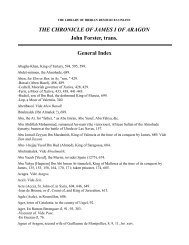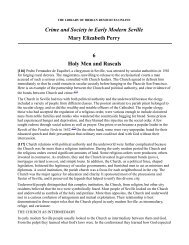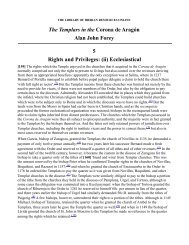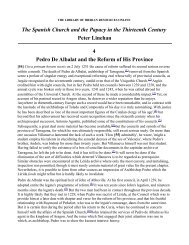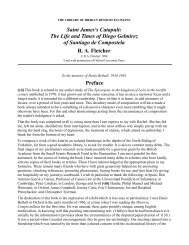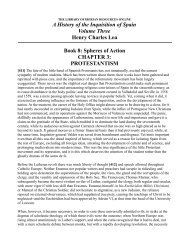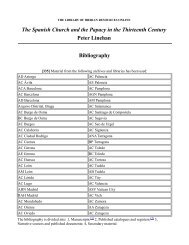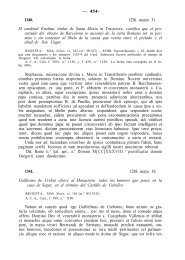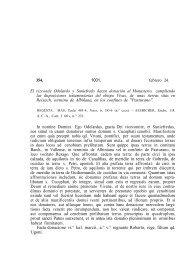Chapter 12 - The Library of Iberian Resources Online
Chapter 12 - The Library of Iberian Resources Online
Chapter 12 - The Library of Iberian Resources Online
You also want an ePaper? Increase the reach of your titles
YUMPU automatically turns print PDFs into web optimized ePapers that Google loves.
Outaïa a dâr is, similarly, twelve hours <strong>of</strong> water. (44)<br />
<strong>The</strong> term expressing the standard unit <strong>of</strong> water measure in most <strong>of</strong> the kingdom <strong>of</strong> Valencia -- the fila<br />
or hilo, "thread," <strong>of</strong> water -- has proven enigmatic to generations <strong>of</strong> scholars: they have neither<br />
understood the rationale <strong>of</strong> the measurement nor [227] have they explained what a "thread" has to do<br />
with water. <strong>The</strong> term "thread <strong>of</strong> water" was known in Andalusí Arabic. In a document <strong>of</strong> <strong>12</strong>23 (619 H.)<br />
describing a water dispute between two towns near Morvedre, the measurement unit is the khait, or<br />
thread. (45) <strong>The</strong> only other pre-modern source known to me that corroborates this usage is Pedro de<br />
Alcalá's translation <strong>of</strong> kait min mi (thread <strong>of</strong> water) as corriente venaje de agua (source-current <strong>of</strong><br />
water). (46) A modern Arabic-French dictionary published in Algiers, and thus reflecting Magribi usage,<br />
defines khait as "saignée a un canal d'irrigation, rigole d'arrosement" (47) that is, not a measure, but the<br />
ditch itself. This usage corresponds to an alternative use <strong>of</strong> fila in Valencia with the meaning <strong>of</strong> ditch or<br />
canal, synonymous with cequia but perhaps connoting a smaller channel.<br />
<strong>The</strong>re is another example <strong>of</strong> the same term expressing both a liquid measure and a channel. In<br />
thirteenth-century Murcia arrova, usually a liquid measure (<strong>of</strong> olive oil, for example) also had the sense<br />
<strong>of</strong> a channel. Alfonso X <strong>of</strong> Castile ordered the sobrecequiero <strong>of</strong> Orihuela to look to the cleaning <strong>of</strong> the<br />
cequias, filas, arnouas, and azarbes. (48)<br />
<strong>The</strong> medieval documentation, especially that <strong>of</strong> Castellón, provides numerous examples <strong>of</strong> important<br />
canals called filas: for example, "la fila dels dos hulls," the "files de la doberia" (that is, adobenia,<br />
tannery), and "les files de Na Orellana." (49) That the Arabic equivalent khait was used in the same way<br />
is clear from two toponyms previously misunderstood. In the town limits <strong>of</strong> Alberic there is a canal<br />
named Alfait with its origin in the same springs that give rise to the Riu dels Ulls. (50) Miguel Asín<br />
Palacios derived Alfait from al-faid, "stream," from the verb "to overflow," so called because the head<br />
is augmented in times when run-<strong>of</strong>f water infiltrates into it. (51) In view <strong>of</strong> the literalism displayed by<br />
medieval Spaniards -- Arabs and Christians alike -- in irrigation terminology, it is much simpler to<br />
derive Alfait from al-khait, "thread" (in the sense <strong>of</strong> fila, "ditch"). (52) Naming a canal "<strong>The</strong> Canal" was<br />
by no means uncommon in the Valencian region. (53) An analogous development is the name <strong>of</strong><br />
Faitanar, one <strong>of</strong> the main canals <strong>of</strong> the Valencian huerta; it is quite clearly [228] derivable from Arabic,<br />
khait al-nahr ("thread <strong>of</strong> the river" in the sense <strong>of</strong> a canal diverted from the river), in spite <strong>of</strong> contrived<br />
efforts to find a Romance derivation for it. (54)<br />
Several passages <strong>of</strong> the Repartimiento <strong>of</strong> Murcia allude to "irrigation <strong>of</strong> alfayt" (that is, "riego de<br />
çequia et dalffayat, se reguen dalfayt" (55) ). <strong>The</strong> editor, possibly following Asín in associating alfayt<br />
with al-faid, understands the term to be flood irrigation (crecida). (56) For reasons already indicated, a<br />
derivation from faid is much less likely than from khait; therefore "riego de equia et dalffayat" most<br />
likely means, simply, irrigation from a large channel and a smaller, secondary one.<br />
HYDRAULIC PLACE NAMES IN VALENCIA AND MURCIA<br />
Many <strong>of</strong> the arabisms discussed above also appear in place names. I shall not attempt to present a<br />
complete description <strong>of</strong> all toponyms having to do with irrigation; enumeration here is limited largely<br />
to arabisms as names <strong>of</strong> hydraulic appurtenances, such as canals and divisors, in order to give a graphic<br />
illustration <strong>of</strong> the Islamic imprint on irrigation.<br />
Of the main canals <strong>of</strong> the huerta <strong>of</strong> Valencia two, in addition to Faitanar, are named with arabisms<br />
bearing hydraulic allusions. <strong>The</strong> Favara Canal derives its name from al-fawwâra, "spring." Nicolau<br />
Primitiu, basing his argument on a single variant, Alfara (which he believes is a shortened form <strong>of</strong><br />
Alfafar) posits a Germanic derivation. (57)




